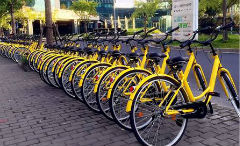Bike sharing: a Chinese internet revolution
2017-04-27
cgtn
Bike sharing schemes are popular in many big cities around the world including London, New York and Paris, but they are perhaps needed more than ever in Shanghai. In this city of 20 million people and awful traffic jams, there is a big push to get people back to pedaling.
As with many things now in China’s modern cities, everything with Shanghai bike sharing happens on smartphones. You sign up on your phone, scan the QR code and then the bike automatically unlocks. Hires only cost one yuan (15 cents) per hour.
That GPS system is key. While traditional bike sharing schemes in Western cities require the bikes to be returned to fixed stations, users of China’s versions can leave bikes wherever they like, ready for the next user to pick them up. GPS allows Mobike to keep track of its bikes and monitor where most bikes are used and where to place them. It also provides useful rider data.
City bike sharing fits into the Chinese government’s strategy of cutting emissions and car journeys but it is also being promoted because it helps create jobs — in the online side of the business but also offline, with the building and distribution of the bikes.
Washington DC has one of the biggest bike sharing programs in the US with 3,700 bikes and 440 stations. The UK, France and Germany all have growing programs. However, China outdoes them all by operating three out of four of the world’s shared bikes.
The Washington DC scheme also has a smartphone app, but it is relatively limited, only showing where the bike stations are located and a couple of bike trails. Users still have to come to a bike station to pick up their ride.
This is one area where China is leading the world.



